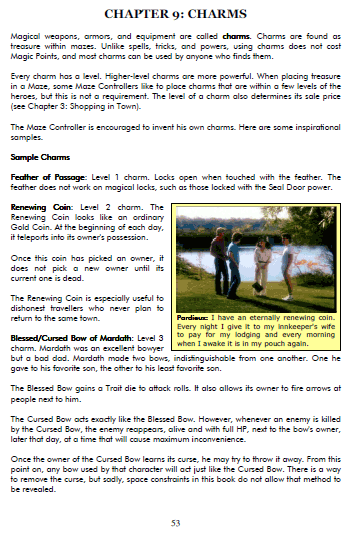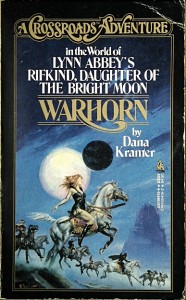I’ve mentioned Crossroads Adventures, the 80’s choose-your-own-adventure series. As far as I know, it didn’t have a D&D license. On the inside of my copy of “Warhorn”, it says “CROSSROADS Adventures are authorized interactive novels compatible for use with any role-playing game.” “Any role-playing game” is remarkably similar to D&D, because the Crossroads mechanics involve +1 swords, healing potions, and Strength, Intelligence, Dexterity, Constitution, Wisdom, and Charisma, all rated 3-18.
Each Crossroads book includes an essay explaining a bunch of gaming terms, including the six D&D attributes. The best part of this essay is that, unlike D&D, it explains each of the 16 possible values for each attribute, and for most of them, includes a real-life example. The examples are worth the price of the book. They’re pretty well thought out; they do a better job of letting you know what it means to have, say, a 15 in an attribute than does D&D. They’re also hilariously 80s.
Here are some highlights:
STRENGTH:
15 A top athlete or football running back [OR? Dis on football running backs?]
17 Changes tires without a jack
18 Wrestles Arnold Schwarzenegger and wins [OK, why not just peg Arnold at STR 17?]
The essay goes on to point out that an elephant “has a Strength of 23.” How do they know?
INTELLIGENCE
6 Curly (The third Stooge)
13 College professor/good quarterback [a lot of football in here!]
15 Indiana Jones/Carl Sagan
18 Leonardo Da Vinci (Isaac Asimov?) [Really? The author of the essay thinks that Asimov is maybe as smart as Da Vinci? I liked The Caves of Steel but let’s not go overboard here. Also, is Asimov verifiably 3 INT points higher than Carl Sagan?]
WISDOM/LUCK [Here’s where Crossroads becomes slightly incompatible from “any game”: it rolls “luck” into the Wisdom stat.]
13 Lee Iacocca
15 Captain Kirk (wisdom) / Conan (luck) [I take issue with both of these. Kirk, as far as I can tell, succeeds entirely based upon Charisma and maybe Luck. I don’t ever recall him making a wise decision.]
17 Sherlock Holmes (wisdom) / Luke Skywalker (luck) [Again, Sherlock Holmes’ skill is clearly Intelligence. And Luke Skywalker, luck? Apparently the author of the essay doesn’t believe in the Force. He thinks that hokey religions and ancient weapons are no match for a good blaster at your side.)
CONSTITUTION
15 Olympic Athlete/Sam Spade [Sam Spade? I guess he has a lot of constitution… I don’t remember much about the Maltese Falcon but I’m willing to believethat Sam got knocked out a few times and survived it.]
16 Marathon runner/Rocky [I agree that Constitution is pretty much Rocky’s strong point.]
18 Rasputin/Batman
DEXTERITY
13 Good fencer/Walter Payton [ah, more football!]
15 brain surgeon/Houdini
16 Flying Karamazov Brothers
17 movie ninja/Cyrano de Bergerac
18 Bruce Lee
A dexterity of 20 is possessed, apparently, by The Waco Kid. From Blazing Saddles. BLAZING SADDLES.
CHARISMA [This one is my favorite.]
7 Richard Nixon today [I wish they had statted Nixon’s Charisma at various points in his career. In China, 14! Jowly appearance vs. Kennedy, 8!]
14 Magnum, P. I. [Only 14???]
16 Henry Kissinger/Jim diGriz [one of these is the Stainless Steel Rat]
18 Dr. Who/Prof. Harold Hill (Centauri) [I have no problem with Dr. Who, but it never would have occurred to me to chart his CHA as 18. And apparently Centauri is a lovable character from the Last Starfighter? and Prof. Harold Hill is from the Music Man? OK, The Music Man is (arguably) timeless, but The Last Starfighter must have JUST COME OUT when this essay was written.]










